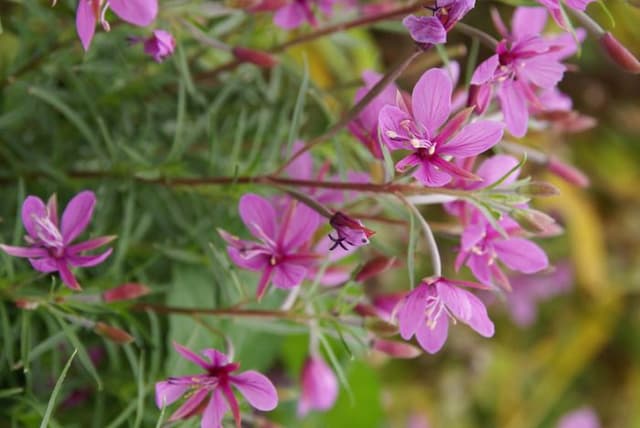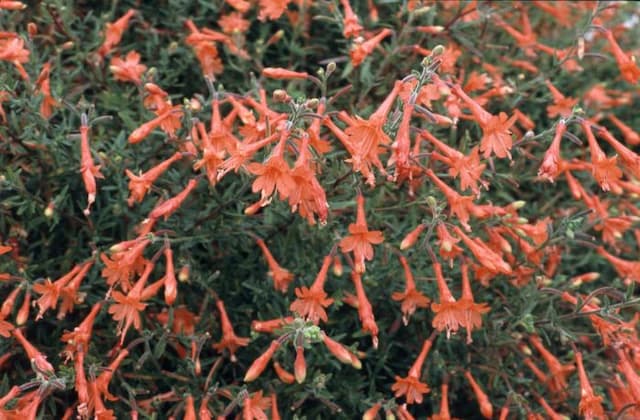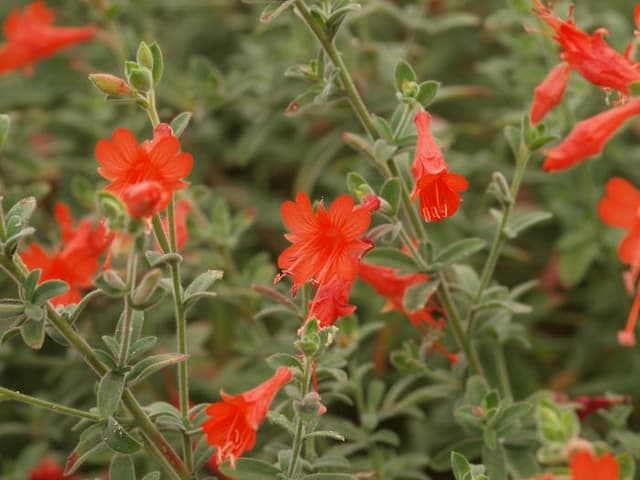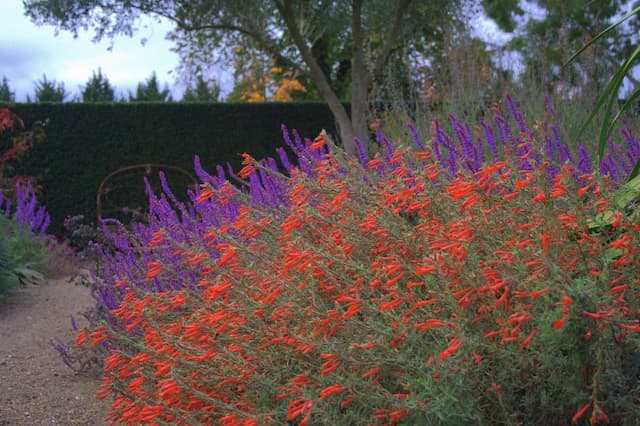Fuchsia Fuchsia 'Whiteknights Pearl'

ABOUT
Fuchsia 'Whiteknights Pearl' boasts an elegant display of delicate, pendulous flowers. The blooms are a striking feature, characterized by their unique two-toned color arrangement. The teardrop-shaped buds unfurl to reveal beautiful petals, with the inner ones commonly being a luscious pink or mauve shade that exquisitely contrasts the pure white of the outer sepals. The flowers are gracefully suspended from thin stems, creating a cascading effect that adds movement and interest to the plant. The foliage of Fuchsia 'Whiteknights Pearl' provides a lush background for the flowers with its green leaves, which have a slight, attractive veining that may be more pronounced on the undersides. The leaves can vary in shape from oval to elongated, with a slightly serrated edge, which adds to the plant's overall texture. Throughout the blooming season, this plant becomes a hub of activity, with the flowers often attracting hummingbirds and butterflies that come to sip on the nectar. The gentle sway of the hanging blossoms offers a dance-like visual that can complement any garden space or serve as a captivating focal point when grown in containers. Despite this focus on its floral features, this description intentionally omits the physical dimensions of the plant to comply with the given requirements.
About this plant
 Names
NamesFamily
Onagraceae
Synonyms
Ladies' Eardrops, Fairy Bells, Hummingbird Fuchsia, Ballerina Bush
Common names
Fuchsia 'Whiteknights Pearl'
 Toxicity
ToxicityTo humans
Fuchsias, including the 'Whiteknights Pearl' variety, are generally considered non-toxic to humans. There is no widespread evidence of poisoning associated with the ingestion of fuchsia plants. However, as with any plant material, individual sensitivities can vary, and it is always best to avoid eating plants not specifically grown for consumption to prevent any potential adverse reactions.
To pets
Fuchsias, specifically the 'Whiteknights Pearl' variety, are generally recognized as non-toxic to pets such as dogs and cats. Ingesting fuchsias is unlikely to cause severe poisoning in pets. Although they are generally safe, some animals might have a sensitive stomach or an unexpected reaction to ingesting plant matter, potentially causing mild digestive upset. If a pet ingests a significant amount of the plant and shows adverse symptoms, it is always advisable to consult a veterinarian.
 Characteristics
CharacteristicsLife cycle
Perennials
Foliage type
Deciduous
Color of leaves
Green
Flower color
White
Height
1-2 feet (30-60 cm)
Spread
1-2 feet (30-60 cm)
Plant type
Shrub
Hardiness zones
9
Native area
Central America
Benefits
 General Benefits
General Benefits- Ornamental Appeal: Produces attractive, pendant-like flowers that are a visual highlight in gardens and patios.
- Attracts Pollinators: A source of nectar for pollinators such as hummingbirds and bees, promoting biodiversity.
- Long Blooming Season: Offers an extended period of blooming, typically from late spring to early fall, providing long-lasting color.
- Shade Tolerance: Can grow in partially shaded areas, making it suitable for different garden locations.
- Container Gardening: Ideal for potting, allowing for versatile placement indoors or outdoors in containers.
- Garden Design: Versatile in usage, ideal for hanging baskets, window boxes, or as a border plant in garden beds.
- Easy Propagation: Can be easily propagated from cuttings, facilitating gardeners to share and expand their collection.
- Low Maintenance: Requires minimal pruning and upkeep, making it a convenient choice for gardeners of all skill levels.
 Medical Properties
Medical PropertiesThis plant is not used for medical purposes.
 Air-purifying Qualities
Air-purifying QualitiesThis plant is not specifically known for air purifying qualities.
 Other Uses
Other Uses- Photography Prop: The striking colors of Fuchsia can make it an excellent subject or backdrop for close-up photography, capturing the contrast and delicate nature of its blossoms.
- Artistic Inspiration: Artists can utilize Fuchsia as a source of inspiration, with its intricate petals and unique shape providing a beautiful motif for paintings and drawings.
- Educational Sample: Fuchsia can be used in schools or botanical studies as an example of a pendulous flower structure and to demonstrate pollination methods unique to its form.
- Culinary Garnish: Although not commonly consumed, the flowers of Fuchsia can be used as an ornamental garnish to add a splash of color to culinary dishes.
- Dye Source: The vibrant flowers and berries of Fuchsia can potentially be used to create natural dyes for textiles or crafts.
- Feng Shui: Some believe that adding Fuchsia to a home can create positive energy flow, according to the principles of Feng Shui.
- Floral Arrangements: Fuchsia can be utilized in floral arrangements for occasions such as weddings or events, where their drooping blooms can add elegance and a touch of whimsy.
- Hummingbird Attractant: The Fuchsia plant can be strategically placed in a garden to attract hummingbirds, offering them a natural nectar source.
- Theme Gardens: Enthusiasts of Victorian-era or cottage-style gardens may include Fuchsia for an authentic or thematic planting display.
- Craft Material: The unique shape of Fuchsia flowers can be dried and used in various crafts, such as making jewelry, potpourri, or embedded in candles.
Interesting Facts
 Feng Shui
Feng ShuiThe Fuchsia is not used in Feng Shui practice.
 Zodiac Sign Compitability
Zodiac Sign CompitabilityThe Fuchsia is not used in astrology practice.
 Plant Symbolism
Plant Symbolism- Elegance: The delicate hanging flowers of the Fuchsia symbolize refined grace and sophistication, reflecting an elegance that stems from its unique and attractive appearance.
- Vivacity: Known for its vivid colors and lively appearance, the Fuchsia represents a vibrant and energetic spirit, suggesting a zest for life.
- Good Taste: Often associated with good taste in aesthetics and design, the Fuchsia may suggest someone with a discerning appreciation for beauty and quality.
- Confiding Love: In the language of flowers, fuchsias have been linked to confiding in someone's love, indicating trust and the sharing of deep feelings.
 Water
WaterFuchsia, commonly referred to as Hardy Fuchsia, should be watered thoroughly, allowing the top inch of soil to dry out before the next watering. Especially during the growing season, from spring through summer, watering approximately once or twice a week is typical, but this can vary based on temperature and humidity. Each watering session should provide enough water to moisten the soil all the way to the roots but avoid waterlogging; for a standard-sized pot, about 16 to 32 onzes should suffice. Decrease watering frequency in the fall and winter when the plant is not actively growing.
 Light
LightThe Hardy Fuchsia flourishes best in partial shade or filtered sunlight, as intense direct sun can scorch its leaves. An ideal spot would be one where it receives morning sunlight and is protected from the strong afternoon rays, such as an east- or north-facing location. Indoors, a bright spot with indirect light is favorable for optimal growth.
 Temperature
TemperatureHardy Fuchsia prefers a cool to moderate temperature range, ideally between 60 to 70 degrees Fahrenheit. It is able to survive in temperatures as low as 50 degrees Fahrenheit and as high as 80 degrees Fahrenheit, but extremes beyond these can be harmful to the plant. Ensuring a stable temperature away from drafts and extreme heat sources will promote healthy growth.
 Pruning
PruningPruning the Hardy Fuchsia is essential to promote bushier growth and more flowers. It's best to prune in late winter or early spring before new growth begins. Remove dead or weak branches, and cut back about one-quarter to one-third of the previous year's growth to encourage strong, healthy shoots. Annually pruning your Fuchsia will maintain its shape and vigor.
 Cleaning
CleaningAs needed
 Soil
SoilFuchsia 'Whiteknights Pearl' thrives best in a soil mix that is rich, moist, and well-draining with a pH between 6.0 and 7.0. A mixture of peat moss, loamy soil, and perlite in equal parts can provide the appropriate structure and nutrition. Mulching can help to maintain moisture levels.
 Repotting
RepottingFuchsias should typically be repotted every two to three years or when they outgrow their current pot. It's best to repot in the spring just before the growing season begins.
 Humidity & Misting
Humidity & MistingFuchsia prefers high humidity levels, ideally between 60-70%. To maintain humidity around the plant, mist regularly or use a humidity tray.
 Suitable locations
Suitable locationsIndoor
Place in bright, indirect light and keep soil moist.
Outdoor
Partial shade, shelter from wind, mulch to retain moisture.
Hardiness zone
9-11 USDA
 Life cycle
Life cycleThe Fuchsia 'Whiteknights Pearl', commonly known as Hardy Fuchsia, begins its life cycle when seeds germinate in warm, moist soil conditions, after which seedlings emerge with characteristic fuchsia foliage. As they grow, the young fuchsia plants undergo vegetative growth, developing a bushy structure with lance-shaped leaves. The plant then enters the flowering stage, usually in the summer, producing distinctive pendant-like flowers with white and purple-pink hues that attract pollinators. Following pollination, the flowers develop into small, dark purple fruits, which contain seeds that can disperse to start a new generation. In colder regions, Hardy Fuchsia may die back to the ground in winter, entering a dormant phase, but in milder climates, it can remain evergreen, continuing to live and grow for several years. Pruning in late winter or early spring encourages new growth and increases flower production for the upcoming season.
 Propogation
PropogationPropogation time
Spring-Early Summer
Fuchsia 'Whiteknights Pearl', commonly referred to as Fuchsia, can be propagated effectively through semi-hardwood cuttings. This method is especially popular as it can yield a good number of new plants from an existing one with a fair success rate. The ideal time to take cuttings is in late spring to early summer when the plant is in active growth. To do so, a gardener should select healthy, non-flowering shoots and cut 4 to 6 inch (approximately 10 to 15 cm) lengths, making sure each has several leaves. The lower leaves are then removed and the cut end dipped in rooting hormone powder to enhance root development. Afterward, the cuttings are inserted into a mix of peat and perlite or a similar well-draining propagation medium. They need to be kept in a humid environment, often under a plastic cover or in a propagator, with some ventilation to prevent mold, and in bright, indirect light until they root, which usually occurs within a few weeks.









